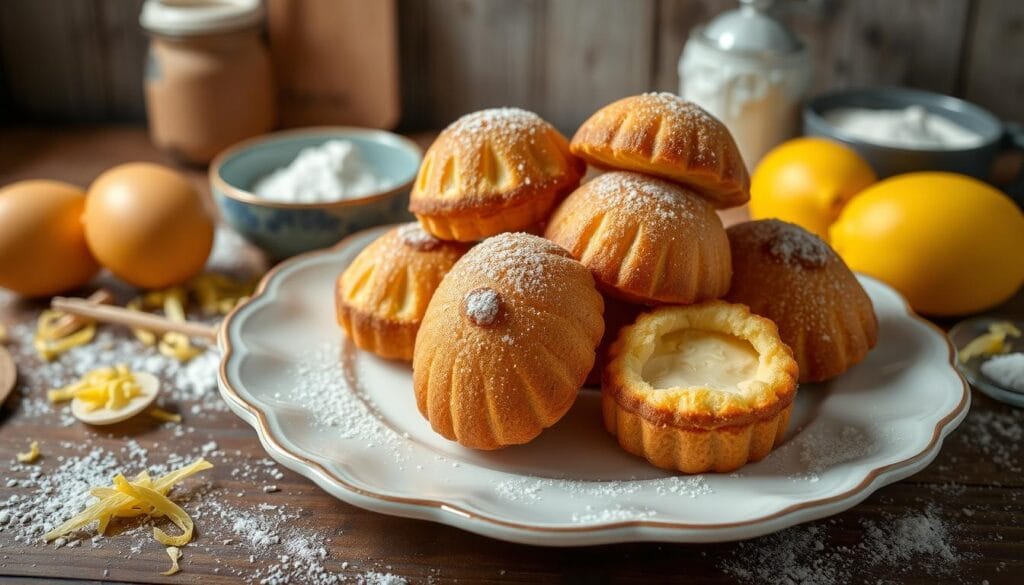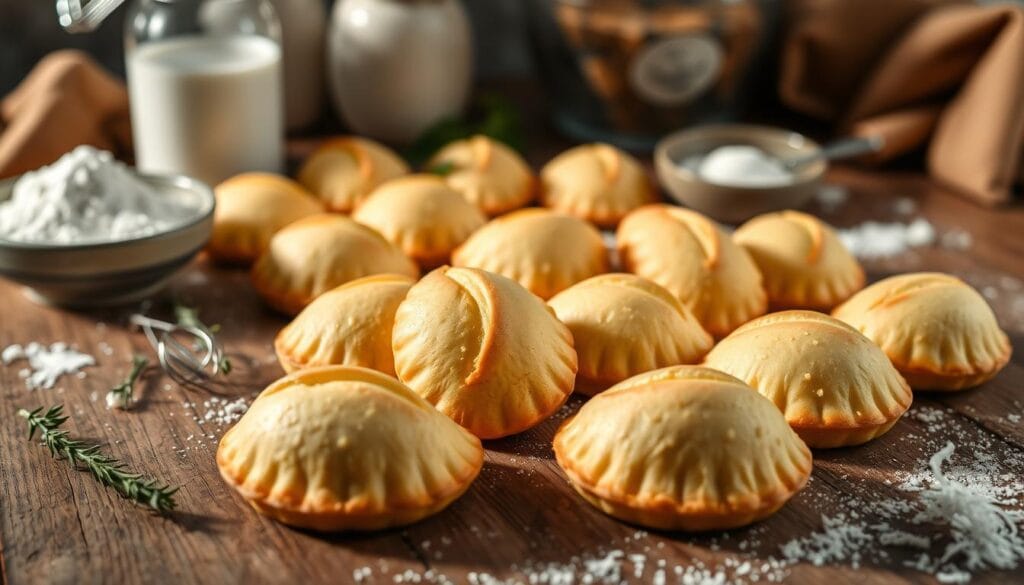Dairy-free madeleines are not just a dream; they are a delightful reality ready to be created and enjoyed right in your own kitchen. Imagine biting into a delicate French pastry that melts in your mouth, without worrying about dairy restrictions.
The world of vegan madeleines opens up a realm of culinary creativity. It transforms traditional French pastry into an inclusive treat that everyone can enjoy. Whether you’re managing food allergies, embracing a plant-based lifestyle, or exploring the world of gluten-free treats, this guide will lead you step-by-step to crafting the perfect dairy-free version of this timeless delicacy.
Our tested recipe promises a 5-star experience, packed with simple ingredients you likely already have in your pantry. From sunflower oil to dairy-free milk, we’ll show you how to craft these shell-shaped delights in under 30 minutes.
Table of Contents
Understanding Traditional Madeleines and Their Origins
French madeleines are more than just simple, shell-shaped cakes; they carry a rich history rooted in Northeastern France, particularly in the Lorraine region, where they originated and became a cherished tradition. Their unique look and taste have made them a favorite treat around the world.

The traditional madeleine recipe showcases French baking artistry. These small, distinctive shell-shaped cakes have won the hearts of pastry lovers for many generations.
History of French Madeleines
The origins of madeleines are filled with culinary legend. Some say they were created by a young servant named Madeleine for nobility. Others believe they were perfected in the Lorraine region over centuries.
“A madeleine is a moment of pure French culinary poetry.” – Anonymous Pastry Chef
Classic Ingredients in Traditional Recipes
A classic madeleine recipe includes:
- High-quality flour
- Granulated sugar
- Fresh eggs
- Almond flour
- Lemon zest for brightness
The Signature Shell Shape
What makes French madeleines special is their distinctive shell shape. Madeleine pans with scalloped edges create this iconic look. The delicate ridges show the traditional French baking craftsmanship.
Pro tip: A well-buttered and floured madeleine pan is crucial for achieving that perfect shell shape and easy release.
Why Choose Dairy-Free Madeleines

Exploring dairy-free madeleines opens a world of tasty options for those with lactose intolerance and vegan bakers. These French treats can be made healthier for everyone, no matter their diet.
Dairy-free madeleines have many benefits:
- They’re great for people with lactose intolerance.
- They’re perfect for those on plant-based diets.
- They have less saturated fat.
- You can customize their flavors.
- They’re a lower cholesterol option compared to traditional recipes.
The nutritional value of dairy-free madeleines is impressive. By substituting butter with plant-based alternatives, you create a treat that is not only delicious but also healthier and suitable for various dietary preferences. Our recipe has about 199 calories per serving, with 4g of protein and just 9g of sugar.
“Baking is about creating joy that everyone can share, regardless of dietary needs.” – Anonymous Pastry Chef
By baking dairy-free madeleines at home, you control what goes into them. You can pick top-notch plant milks and try different flours. This way, you can make a dessert that fits your diet while keeping the classic French pastry’s taste and texture.
Essential Ingredients for Dairy-Free Madeleines
To make dairy-free madeleines, you need to pick the right ingredients. The success of your baking depends on the non-dairy milk, vegan butter substitutes, and egg replacers. These should keep the classic taste and texture.
Plant-Based Milk Options
Choosing the right non-dairy milk is key for tasty madeleines. Each type of plant-based milk adds something special to your recipe:
- Soy milk: Provides protein and creamy consistency
- Almond milk: Offers light, nutty undertones
- Oat milk: Delivers rich, smooth texture
- Coconut milk: Adds subtle tropical flavor
Oil Alternatives to Butter
Vegan butter substitutes are important for the taste and texture of your madeleines. Here are some oil alternatives:
| Oil Type | Flavor Profile | Best Used For |
|---|---|---|
| Sunflower Oil | Neutral | Classic madeleines |
| Avocado Oil | Mild, buttery | Rich, smooth texture |
| Melted Coconut Oil | Slight coconut hint | Tropical-inspired variations |
Additional Ingredient Substitutions
For dairy-free madeleines, you need to swap out ingredients smartly. Egg replacers are key to keeping the light, fluffy texture. Xanthan gum is also important in gluten-free flour blends for binding.
“The secret to perfect dairy-free madeleines lies in understanding how each ingredient contributes to the final result.”
For great dairy-free madeleines, add vanilla extract for depth, lemon juice for brightness, and citrus zest for a vibrant finish. Try different combinations to find your favorite dairy-free madeleine recipe!
Required Equipment and Tools
Making delicious madeleines needs special baking tools. Your madeleine pan is key. It should be either a metal pan or silicon molds for that classic shape.
- Madeleine pan (metal or silicon molds)
- Electric mixer or whisk
- Mixing bowls
- Measuring cups and spoons
- Cooling rack
- Piping bag (optional)
- Non-stick cooking spray
When picking a madeleine pan, think about these points:
| Pan Type | Pros | Cons |
|---|---|---|
| Metal Pan | Traditional, even heat distribution | Requires greasing, can rust |
| Silicon Molds | Non-stick, easy to clean | May not provide crisp edges |
Pro tip: Chill your madeleine pan in the freezer for about 15 minutes before baking. This helps create the signature hump and prevents sticking.
“The right baking tools can transform your madeleines from good to extraordinary.” – Professional Pastry Chef
Can I Make These Madeleines Dairy-Free?
Turning traditional madeleine recipes into dairy-free treats is a fun journey. With the right tips and strategies, you can make delicious madeleines that are just as good as the French originals.
Converting Traditional Recipes
Converting recipes to be dairy-free needs careful planning. Start by learning about the best substitutes:
- Butter → Coconut oil or plant-based margarine
- Milk → Unsweetened almond milk or oat milk
- Eggs → Keep original or use egg replacer
Common Challenges and Solutions
When baking vegan, you might face some challenges. Making sure your madeleines have the right texture and rise is key.
| Challenge | Solution |
|---|---|
| Lack of Traditional Hump | Chill batter for 8 hours before baking |
| Dense Texture | Use gluten-free flour blend |
| Flat Appearance | Preheat madeleine pan |
Tips for Success
Getting great dairy-free madeleines takes skill and patience. Here are some tips from experts:
- Use exact measurements
- Chill batter overnight
- Preheat pan at 460°F (240°C)
- Do not overmix batter
“The secret to perfect dairy-free madeleines lies in technique, not just ingredients.” – French Pastry Chef
Follow these tips to make delicious, allergy-friendly madeleines. Try new things, adapt, and have fun with your baking!
Step-by-Step Baking Instructions
Mastering the madeleine baking process needs precision and patience. These French shell-shaped cookies require careful preparation. This ensures their signature texture and look. Let’s go through the key steps for perfect homemade madeleines.
Before starting, make sure to gather all your ingredients and organize your kitchen. In fact, the secret to baking perfect madeleines lies in carefully following these essential tips:
- Prepare the madeleine pan by thoroughly greasing each shell-shaped cavity
- Ensure all ingredients are at room temperature
- Chill the batter for optimal results
Your baking timeline will look like this:
| Preparation Stage | Time Required |
|---|---|
| Batter Preparation | 10 minutes |
| Batter Chilling | 30-60 minutes |
| Baking Time | 10-13 minutes |
| Total Time | 2 hours |
For mixing, separate your dry and wet ingredients. Fold the ingredients gently to keep the delicate air bubbles that make the madeleine texture. Remember, use a light hand when mixing for a tender crumb.
“The secret to perfect madeleines is in the technique, not just the ingredients.” – French Pastry Chef
Preheat your oven to 400°F (204°C) for baking. Fill each mold about 3/4 full with batter. Watch closely during the last few minutes to get that golden-brown color and distinctive hump.
- Bake until edges are golden brown
- Cool briefly in the pan
- Transfer to a wire rack
- Dust with powdered sugar if desired
Your homemade madeleines are best enjoyed warm, with coffee or tea. They stay fresh for up to 4 days in an airtight container at room temperature.
Achieving the Perfect Texture
Getting the right madeleine texture is an art. It needs precision and knowing the right baking techniques. The perfect madeleine is light, spongy, and has a golden-brown color with crisp edges.
To make the perfect madeleine, several key elements matter. Bakers must focus on the right mix of ingredients, how they mix, and controlling the temperature.
Creating the Signature Hump
The signature hump is what makes a madeleine special. To get this, follow these important baking steps:
- Chill the batter for at least one hour before baking
- Use a precise oven temperature of 400°F for the first 6 minutes
- Drop the temperature to 365°F for the remaining 4 minutes
- Make sure your madeleine pan is ready
Troubleshooting Baking Problems
When making madeleines, you might occasionally encounter some challenges; however, understanding the common pitfalls can help you overcome them with ease. Here are fixes for common texture problems:
| Problem | Possible Cause | Solution |
|---|---|---|
| Dense Texture | Overmixing batter | Fold ingredients gently, avoid deflating |
| No Hump Formation | Insufficient batter chilling | Refrigerate batter for minimum 1 hour |
| Sticking to Pan | Inadequate pan preparation | Butter and flour pan thoroughly |
Professional bakers suggest using a digital kitchen scale for exact measurements. They also recommend a dedicated madeleine pan for consistent results. Remember, the more you practice, the better you’ll get at making madeleines.
Flavor Variations and Add-ins
Make your madeleines special with creative twists. Try citrus or chocolate madeleines for a new taste. There are endless ways to spice up your baking.
Here are some exciting flavor combinations to elevate your madeleines:
- Citrus Infusions: Add zest from oranges, lemons, or grapefruits for a bright taste
- Chocolate Lovers: Mix in cocoa powder for rich chocolate madeleines
- Try aromatic extracts like almond or rose
- Add warming spices like cardamom or cinnamon
Chocolate lovers, here are some great ideas:
- Dip cooled madeleines in melted dairy-free chocolate
- Fold in dairy-free chocolate chips
- Sprinkle finely chopped nuts for extra texture
“The secret to amazing madeleines is not just in the recipe, but in the creative spirit of the baker.”
Pro tip: To begin with, start with small batches when experimenting with new madeleine flavors. This way, you can adjust the recipe as needed without wasting ingredients. Each twist adds a unique touch to these French treats.
Storage and Shelf Life
Keeping your homemade dairy-free madeleines fresh is key. The right storage keeps their delicate texture and flavor intact. This way, you can enjoy every bite to the fullest.
Optimal Storage Methods
Fresh madeleines are best eaten quickly. At room temperature, they stay fresh for 1-2 days in an airtight container. For longer storage, try these options:
- Room Temperature Storage: Keep in a sealed container away from direct sunlight
- Refrigerator Storage: Extends shelf life up to 5-7 days
- Use a container with a tight-fitting lid to prevent moisture
Freezing Baked Goods: Madeleine Edition
Freezing madeleines is a great way to keep their taste and texture. Here are some expert tips for freezing:
| Storage Method | Shelf Life | Recommended Technique |
|---|---|---|
| Freezer Storage | Up to 2 months | Individually wrap in plastic wrap |
| Vacuum-Sealed Bag | Up to 10 days | Remove excess air before sealing |
Thawing and Reheating
Ready to enjoy your frozen madeleines? Here’s how:
- Remove from freezer and let thaw at room temperature (about 30 minutes)
- Reheat in oven at 300°F (150°C) for 5-10 minutes
- Serve warm for best flavor and texture
“The secret to maintaining madeleine perfection is in the storage” – French Pastry Chef
Pro tip: Always cool madeleines completely before storing to prevent condensation and soggy texture.
Serving Suggestions and Presentation
Make your dairy-free madeleines stand out with creative serving ideas. These classic French desserts can become stunning tea time treats. Their delicate shell shape offers endless presentation options to wow your guests.
- Dust with powdered sugar for a classic French bakery look
- Drizzle with dairy-free chocolate for extra indulgence
- Pair with fresh fruit compote or berry coulis
- Create holiday-themed decorations using colored dairy-free white chocolate
Pairing your madeleines with the right drinks can enhance the experience. Try serving them with:
- Hot espresso
- Herbal tea
- Dairy-free hot chocolate
- Fresh mint tea
“A madeleine is a moment of pure culinary poetry.” – French Pastry Chef
At a tea party or afternoon gathering, display your madeleines on a stunning platter. Add edible flowers, cocoa powder, or artistic chocolate drizzles. This will make your presentation unforgettable.
| Serving Occasion | Recommended Presentation |
|---|---|
| Breakfast | Light dusting of powdered sugar |
| Afternoon Tea | Chocolate-dipped ends |
| Dessert | Fruit compote alongside |
| Holiday | Themed decorative chocolate coating |
Remember, presentation is an art. Your dairy-free madeleines can be a canvas for creativity. They can turn simple treats into extraordinary culinary experiences.
Conclusion
Your journey to making delicious homemade dairy-free madeleines is more than just about baking; instead, it’s a delightful experience filled with creativity and care. Moreover, by embracing this process, you not only create a tasty treat but also a moment of joy to share with others. It’s a celebration of creativity in the kitchen. You’ve learned that traditional French pastries can be made at home with simple changes.
Vegan baking is not about what you can’t do. It’s about finding new ways to enjoy food. You’ve shown that you can make tasty, delicate treats without dairy.
Every batch of homemade dairy-free madeleines is a chance to get better. Try different milks and flavors. Make the recipe your own. The fun of baking is in the creativity and sharing with loved ones.
Your success in making these French pastries shows that you can break through culinary limits. Keep baking, learning, and enjoying the tasty results of your dairy-free madeleine adventures.

